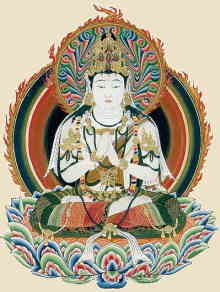SelfDefinition.Org
Tantra Articles

Kukai (Kobo Daishi) and Shingonby Alex Wayman
Kukai: This remarkable Japanese scholar-monk (774-835), also called posthumously Kobo Daishi, of multi-faceted talent, exemplifies the search for the guru in another country (China) and the bringing back of the esoteric Buddhist lineage to Japan. Later, as Hakeda informs us, [1] Kukai denied that esoteric Buddhism was propounded by the historical Buddha, as Buddhists of his era generally believed.
[1. Yoshito S. Hakeda, Kukai: Major Works NY, 1972. ]
Kukai went to China to find out the meaning of the scripture called Mahavairocana-sutra [2] which had become available in Japan by a copy in 736 of the Chinese version.
[2. en.wikipedia.org/wiki/
This scripture, called in the Indo-Tibetan tradition the Vairocanabbisambodbi-tantra, has many difficult and obscure passages. The present writer published a work on this, [3. need] reporting that it is a wedding of esoteric doctrine with the Buddhism descended from the historical Buddha and composed circa mid-sixth century AD in the area of present-day Maharashtra. This lineage was transmitted to China in 716 AD with the arrival of Subhakarasiqiha, who translated the text into Chinese with the help of I-hsing.
When Kukai returned to Japan after studying the scripture through Sanskrit and Chinese, and having gained the corpus of tantric "secrets", he prepared various works explaining this and associated esoteric texts. But Hakeda reports that his writings were also hard to understand, partly because he wrote in ornate classical Chinese with many Sanskrit terms in Chinese transcription and translation, and partly because of the subtlety of the material.
To illustrate the continuity of the guru transmissal, we may take the example of the "six elements", since Sariputia had related these to the dying Anathapindika, and the esoteric school of Japan makes much of them. Hakeda translates the lines for the first five of these from the Chinese Mahavairocana sutra.
I have realized that which is unborn,
It is that which language cannot communicate;
It is free from all defilements.
It transcends causality;
I know that it is void like space.
My own translation is from the Tibetan version and includes the line for the sixth element, vijnana.
I have comprehended "non-arising",
have dropped off the domain of speech,
negated all faults,
and lack causes and conditions.
I have the knowledge of voidness like space.
I am freed from all darkness.
Here, earth is "non-arising", water washes away speech; fire negates all faults, wind lacks cause and conditions, space is like voidness, and vijnana (when the Buddha's) is freed from all darkness. Hence, this scriptural way of referring to the six elements is tantamount to the riddles which deities have tested the Buddha within the initial verse section of the Pali Samyutta-Nikaya. This scripture, the Mahavairocana-sutra has many such obscure lines, which prompted Kukai on his perilous and remarkably fruitful trip to China, for gaining the lineage of the gurus, then upon returning, to start the sect called Shingon.
See on this site: Kukai's Sokushin-Jobutsu-Gi, Principle Of Attaining Buddhahood With The Present Body: /tantra/